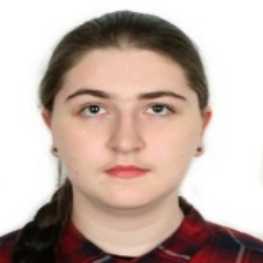
Sofia Chyrun
Work place: Telecommunication Department, Lviv Polytechnic National University, Lviv, 79013, Ukraine
E-mail: sofiia.chyrun.sa.2022@lpnu.ua
Website:
Research Interests:
Biography
Sofia Chyrun is a student at the Telecommunication Department at Lviv Polytechnic National University. Her main research interests are fake identification, natural language processing, computer linguistics, data science, web technologies, data science, system analysis, information technologies, machine learning, Cisco Systems, information systems and networks, and cyber security.
Author Articles
Intelligent Application for Textual Content Authorship Identification based on Machine Learning and Sentiment Analysis
By Dmytro Uhryn Victoria Vysotska Lyubomyr Chyrun Sofia Chyrun Cennuo Hu Yuriy Ushenko
DOI: https://doi.org/10.5815/ijisa.2025.02.05, Pub. Date: 8 Apr. 2025
During the development and implementation of the software system for text analysis, attention was focused on the morphological, syntactic and stylistic levels of the language, which made it possible to develop detailed profiles of authorship for various writers. The main goal of the system is to automate the process of identifying authorship and detecting plagiarism, which ensures the protection of intellectual property and contributes to the preservation of cultural heritage. The scientific novelty of the research was manifested in the development of specific algorithms adapted to the peculiarities of the natural language, as well as in the use of advanced technologies, such as deep learning and big data. The introduction of the interdisciplinary approach, which combines computer science, linguistics, and literary studies, has opened up new perspectives for the detailed analysis of scholarly works. The results of the work confirm the high efficiency and accuracy of the system in authorship identification, which can serve as an essential tool for scientists, publishers, and law enforcement agencies. In addition to technical aspects, it is vital to take into account ethical issues related to confidentiality and copyright protection, which puts under control not only the technological side of the process but also moral and legal norms. Thus, the work revealed the importance and potential of using modern text processing methods for improving literary analysis and protecting cultural heritage, which makes it significant for further research and practical use in this area.
[...] Read more.Agile Intelligent Information Technology for Speech Synthesis Based on Transfer Function Approximation Methods Using Continued Fractions
By Lyubomyr Chyrun Victoria Vysotska Sofia Chyrun Zhengbing Hu Yuriy Ushenko Dmytro Uhryn
DOI: https://doi.org/10.5815/ijigsp.2025.02.01, Pub. Date: 8 Apr. 2025
The study considers the methodology of using continued fractions to approximate transfer functions in speech synthesis systems. The main results of the research are an increase in the accuracy of approximation, acceleration of calculations, and a new method of convergence analysis. The use of continued fractions allowed for a reduction in the error of approximation of transfer functions compared to classical methods. With an error of 1.0E-06, the continued fraction method requires only 3–13 terms, while the power series requires 3–15 terms. The use of continued fractions reduced the time for calculating transfer functions by 2–3%. It was determined that the most effective for calculating the values of continued fractions are the Δ-algorithm and the α-algorithm. A new criterion for the convergence of continued fractions is proposed, which allows the sum fractions that are "divergent" in the classical sense. The graphs used to classify different types of continued fractions allowed us to better understand their structure and potential for application in speech synthesis. Software for calculating transfer function values based on continued fraction decomposition has been developed and tested. It has allowed automation of the approximation process and increased the efficiency of speech synthesis systems. The results obtained have allowed improving the quality of synthesised speech while simultaneously reducing the complexity of calculations. Systems using continued fractions consume less memory and provide more accurate voice reproduction. In summary, the work presents a new approach to the approximation of transfer functions, which is essential for optimising speech synthesis systems.
[...] Read more.Other Articles
Subscribe to receive issue release notifications and newsletters from MECS Press journals